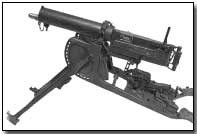Encyclopedia - Maschinengewehr
 With a number of variations of the Maschinengewehr 08
produced during the First World War, it was the German Army's standard
machine gun and comprised an almost direct copy of
Hiram S. Maxim's
original 1884 Maxim
Gun.
With a number of variations of the Maschinengewehr 08
produced during the First World War, it was the German Army's standard
machine gun and comprised an almost direct copy of
Hiram S. Maxim's
original 1884 Maxim
Gun.
Like the Maxim Gun the Maschinengewehr 08 (or MG08) - so-named after its year of adoption, 1908 (itself based upon an earlier 1901 model) - was water-cooled (via a jacket around the barrel which held approximately one gallon) and could reach a firing rate of up to 400 7.92mm rounds from a 250-round fabric belt per minute, although sustained firing would lead to over-heating.
The MG08, like the Maxim Gun, operated on the basis of a toggle lock; once cocked and fired the MG08 would continue firing rounds until the trigger was released. Its practical range was estimated at some 2,200 yards up to an extreme range of 4,000 yards.
The MG08 was mounted on a sledge ('Schlitten') which was ferried between locations either on carts or else carried above men's shoulders in the manner of a stretcher.
When war began in August 1914 approximately 12,000 MG08s were available to battlefield units; production, at numerous factories, was however markedly ramped up during wartime. In 1914 some 200 fresh MG08s were produced each month; by 1916 - once the device had established itself as the pre-eminent defensive battlefield weapon - the number had increased to 3,000; and a year later to a remarkable 14,400 per month.
A revised version of the Maschinengewehr was produced in 1915 - the MG08/15 - which featured a bipod rather than sledge mount plus a pistol butt. Less heavy (at 18kg) and cumbersome it was intended to demonstrate better mobility on the battlefield; it nevertheless remained a bulky weapon which was chiefly used for defensive purposes. It was however placed to some use as an aircraft weapon.
In 1918 an air-cooled and genuinely mobile model - the MG08/18 weighing 15kg - entered into production, intended for forward use by advancing infantrymen, i.e. as an aggressive rather than simply defensive weapon. In the event these proved of most use in covering the German Army's withdrawal during the latter half of 1918.
Ack Ack was a term used to describe anti-aircraft fire.
- Did you know?
